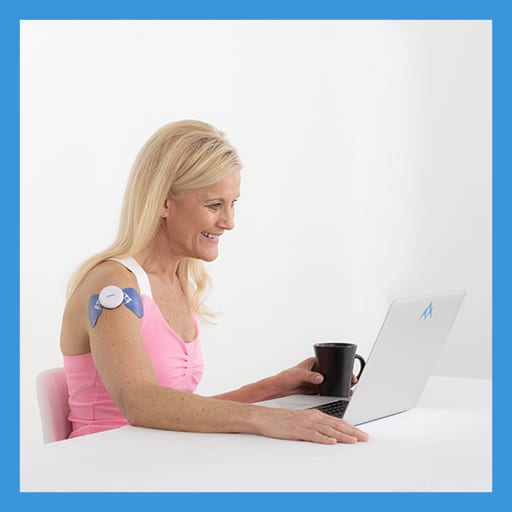A Guide to Electrical Stimulation Therapy for Stroke Patients

In simple terms, electrical stimulation is the sending of electrical impulses to generate a muscle contraction. This is usually done via surface electrodes stuck to the skin over the target area. The muscle contraction may be very small to help with pain or sensation, or it may be large enough to produce a visible movement at a joint.
Following a stroke or other neurological injury, you may be left with muscle weakness or complete loss of movement (sometimes called hemiplegia). You may also experience a sudden inability to perform everyday tasks, sensory loss, pain, or a combination of these symptoms.
Depending on your unique symptoms, there are a variety of electrical stimulation devices and therapies from which you may benefit. First, it is important to understand the different types of electrical stimulation and how they are used to treat pain, sensory deficits, muscle weakness, and other common conditions caused by stroke. Once you understand what it is you are attempting to treat, you can decide which e-stim devices are most appropriate to help you reach your recovery goals.
Types of Electrical Stimulation for Stroke Recovery
There are multiple types of electrical stimulation used in the treatment of stroke:
- EMS (Electrical Muscle Stimulation)
- NMES (Neuromuscular Electrical Stimulation)
- FES (Functional Electrical Stimulation)
- TENS (Transcutaneous Electrical Nerve Stimulation)
- SES (Sensory Electrical Stimulation)
- ETS (EMG Triggered Stimulation)
- RETS (Reciprocal EMG Triggered Stimulation)
EMS/NMES -- The terms EMS and NMES are sometimes used interchangeably. NMES is the most common term used for electrical stimulation therapy for stroke patients. NMES is the generation of a muscle contraction by the electrical stimulation, resulting in the movement of a joint. The benefits include improved muscle strength, increased range of movement of the targeted muscles, and reduced spasticity (sometimes referred to as tone).
FES – Functional Electrical Stimulation is the use of NMES to promote a functional activity such as grasping a utensil for feeding or reaching for a door handle.
TENS - Transcutaneous Electrical Nerve Stimulation is used for pain relief by helping to prevent pain signals from reaching the brain. No muscle contraction occurs, and a tingling sensation is felt.
SES – Sensory Electrical Stimulation is a low-level stimulation to excite the sensory system. No muscle contraction occurs, but it is used to help reduce spasticity in the arm and improve sensation and neglect. By stimulating the brain, SES can also help improve motor activity.
ETS – EMG Triggered Stimulation uses recovering movement from the stroke patient to trigger the electrical stimulation during a joint movement. The benefit of this is the increased participation of the stroke patient.
RETS – Reciprocal EMG Triggered Stimulation helps the stroke patient to relax overactive muscles, such as those that grasp, before providing electrical stimulation to the opposing muscle (those that open the hand). This is helpful for stroke patients whose hands regularly close into a fist. It will help them learn how to relax their grip before stimulating the opening of the hand.
Which e-stim device should I choose for better recovery after stroke?
Once you have decided what type of electrical stimulation therapy you need, you can narrow down the best e-stim devices for recovery after stroke.
At Saebo, we have a growing range of electrical stimulation devices for stroke recovery, depending on your rehabilitation needs.
SaeboStim One
This wireless, wearable e-stim device has one pre-set NMES program for ease of use and is ideal to treat shoulder subluxation, foot drop, and arm or hand weakness after stroke.
SaeboStim Pro
This electrical stimulation device includes a comprehensive range of programs to choose from: NMES for muscle strengthening, TENS for pain relief, and sensory stimulation with our Sensory Electrical Stimulation (SES) Accessory Kit. In addition, the unique trigger button allows you to use it as a Functional Electrical Stimulation (FES) device to practice everyday tasks.
SaeboStim Micro
This unique e-stim glove and sleeve deliver sensory electrical stimulation (SES) to the whole hand and arm through the daytime or nighttime program.
SaeboStim Spa
The SaeboStim Spa provides extremely safe, low-level electrical stimulation designed to improve sensation, reduce spasticity, improve function, and decrease pain in the foot. The device works by submerging the involved foot, along with the associated rubber electrodes, into the water for a 30-minute stimulation session.
When should I not use electrical stimulation therapy for stroke recovery?
There are some medical conditions for which electrical stimulation therapy is not safe to use.
If you have a pacemaker, uncontrolled epilepsy, uncontrolled atrial fibrillation, or are pregnant, you should not use this type of therapy. When in doubt, contact your physician or a trained therapist for advice.
All content provided on this blog is for informational purposes only and is not intended to be a substitute for professional medical advice, diagnosis, or treatment. Always seek the advice of your physician or other qualified health providers with any questions you may have regarding a medical condition. If you think you may have a medical emergency, call your doctor or 911 immediately. Reliance on any information provided by the Saebo website is solely at your own risk.
All content provided on this blog is for informational purposes only and is not intended to be a substitute for professional medical advice, diagnosis, or treatment. Always seek the advice of your physician or other qualified health providers with any questions you may have regarding a medical condition. If you think you may have a medical emergency, call your doctor or 911 immediately. Reliance on any information provided by the Saebo website is solely at your own risk.



